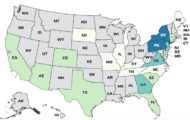Minnesota PFAS fish consumption guidance has been updated by the Minnesota Department of Health (MDH). PFAS is per- and polyfluralkyl substances that are found in some waters in 10 Minnesota counties. In the Twin Cities area, the counties of Anoka, Carver, Dakota, Hennepin, Ramsey, and Washington counties are affected. In greater Minnesota, waters in Douglas, Martin, McLeod and St. Louis counties are affected.

PFAS are chemicals that are harmful to human health. They are used to make products that are resistant to heat, oil, stains, grease, and water. These chemicals can accumulate in the body over time and can affect health. They are tied to developmental effects, including low birth weight in infants and a weaker immune system in children. Exposure to PFAS can cause changes in liver function and may increase cancer risks.
The new guidelines say that no one should eat these fish:
All species of fish caught in Minnesota River Valley ponds and Long Meadow Lake (Hennepin County).
Bass caught in Mooney Lake (Hennepin County).
Walleye caught in George Lake (Martin County).
Yellow perch and common carp caught in Otter Lake, McCuen Creek, Bear Creek and the south fork of the Crow River (McLeod and Carver counties).
The new guidance is less restrictive than before for rainbow smelt caught in Lake Superior. MDH has found that it is okay to eat up to one serving of this fish per week.
Angela Preimesberger, MDH’s fish consumption guidance program lead said in a statement, “Our fish consumption guidance can help anglers and their families make informed choices about which fish to eat and how often. Following the guidance enables you to reduce your exposure to contaminants while still enjoying the many benefits of eating fish, which is an important part of a healthy, well-balanced diet.”
You can find the rest of the new guidance, which includes a list of affected bodies of water by county, on MDH’s Fish Consumption Guidance web page.”




